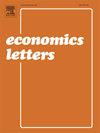How does opioid prevalence affect surgery decisions?
IF 2.1
4区 经济学
Q2 ECONOMICS
引用次数: 0
Abstract
This paper studies how the prevalence of opioids affects joint physician–patient decisions over medical procedures. Following Alpert et al. (2022), we utilize variation in opioid exposure due to state policies that affected OxyContin’s marketing and market entry. Our results suggest that higher availability of opioids led to a substantial (21%) increase in the number of elective surgical discharges, such as knee replacements, hip replacements, and back surgeries. We also consider effects for non-elective surgical discharges — procedures where we expect a much smaller response to the availability of opioids — and find a statistically insignificant increase of 1%. Finally, we investigate medical discharges — procedures where no response is expected — and find no detectable effect. This increase in elective procedures is consistent with a model of physician behavior that incorporates patient pain and post-surgical well-being into surgical decisions and where decreases in the “hassle” of prescribing pain-reducing medication pushes marginal patients to undergo surgeries that they might not otherwise elect. Our results highlight an important tradeoff: while liberal opioid prescribing has led to widespread misuse and abuse, the availability of opioids may allow some patients to undergo quality-of-life improving surgeries that would otherwise be too painful.
阿片类药物的流行如何影响手术决策?
本文研究了阿片类药物的流行如何影响医患联合决策的医疗程序。根据Alpert等人(2022)的研究,我们利用影响奥施康定营销和市场进入的国家政策导致的阿片类药物暴露变化。我们的研究结果表明,阿片类药物的高可用性导致选择性手术出院数量大幅增加(21%),如膝关节置换术、髋关节置换术和背部手术。我们还考虑了非选择性手术出院的影响-我们期望对阿片类药物可用性的反应要小得多的手术-并发现统计上微不足道的1%的增加。最后,我们调查医疗出院-程序没有反应的预期-并没有发现可检测的影响。选择性手术的增加与医生的行为模式是一致的,这种模式将患者的疼痛和术后健康纳入手术决策中,并且减少了处方止痛药的“麻烦”,促使边缘患者接受他们可能不会选择的手术。我们的研究结果强调了一个重要的权衡:虽然自由的阿片类药物处方导致了广泛的误用和滥用,但阿片类药物的可用性可能会让一些患者接受改善生活质量的手术,否则这些手术会太痛苦。
本文章由计算机程序翻译,如有差异,请以英文原文为准。
求助全文
约1分钟内获得全文
求助全文
来源期刊

Economics Letters
ECONOMICS-
CiteScore
3.20
自引率
5.00%
发文量
348
审稿时长
30 days
期刊介绍:
Many economists today are concerned by the proliferation of journals and the concomitant labyrinth of research to be conquered in order to reach the specific information they require. To combat this tendency, Economics Letters has been conceived and designed outside the realm of the traditional economics journal. As a Letters Journal, it consists of concise communications (letters) that provide a means of rapid and efficient dissemination of new results, models and methods in all fields of economic research.
 求助内容:
求助内容: 应助结果提醒方式:
应助结果提醒方式:


